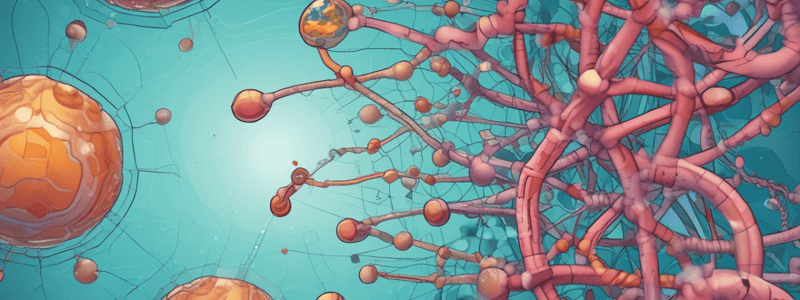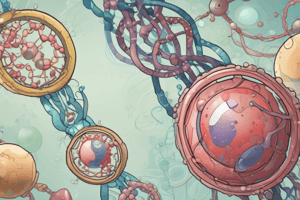Podcast
Questions and Answers
What is the major modification proposed by the Double-strand Break Model to the Holliday model?
What is the major modification proposed by the Double-strand Break Model to the Holliday model?
- A break in both strands of one chromatid (correct)
- A nick in one strand and a break in the other strand
- Two nicks in the same location on two strands
- A single-strand break in one chromatid
What is the primary function of the protein Spo11 in Saccharomyces cerevisiae?
What is the primary function of the protein Spo11 in Saccharomyces cerevisiae?
- Repairing DNA double-strand breaks
- Forming Holliday Junctions
- Breaking the DNA to create double-strand breaks (correct)
- Initiating branch migration
What is the outcome of the double-strand break model?
What is the outcome of the double-strand break model?
- Formation of a Holliday Junction
- Sites where a crossover will occur (correct)
- Creation of a heteroduplex
- Resolution of the recombination process
What is the number of proteins required for the formation of DNA double-strand breaks in Saccharomyces cerevisiae?
What is the number of proteins required for the formation of DNA double-strand breaks in Saccharomyces cerevisiae?
What is the stage of recombination where the double-strand break model is involved?
What is the stage of recombination where the double-strand break model is involved?
What is the name of the model that proposes two nicks in the same location on two strands?
What is the name of the model that proposes two nicks in the same location on two strands?
What is the result of the DNA gap repair synthesis?
What is the result of the DNA gap repair synthesis?
What is the molecular mechanism that occurs after the formation of DNA double-strand breaks?
What is the molecular mechanism that occurs after the formation of DNA double-strand breaks?
What is the term used to describe the phenomenon in which one allele is converted to the allele on the homologous chromosome?
What is the term used to describe the phenomenon in which one allele is converted to the allele on the homologous chromosome?
What is the structure formed during homologous recombination that has been called a chi (χ) form?
What is the structure formed during homologous recombination that has been called a chi (χ) form?
What is the process by which the Holliday junction is resolved?
What is the process by which the Holliday junction is resolved?
What occurs during branch migration in homologous recombination?
What occurs during branch migration in homologous recombination?
What is the region of DNA that contains a mix of genetic information from both parental chromosomes?
What is the region of DNA that contains a mix of genetic information from both parental chromosomes?
What is the model of homologous recombination that involves the formation of a double-strand break?
What is the model of homologous recombination that involves the formation of a double-strand break?
What is the term used to describe the exchange of corresponding segments between homologous chromosomes?
What is the term used to describe the exchange of corresponding segments between homologous chromosomes?
What is the process by which homologous chromosomes align and exchange genetic information?
What is the process by which homologous chromosomes align and exchange genetic information?
What is the initial event in the homologous recombination process according to the Holliday model?
What is the initial event in the homologous recombination process according to the Holliday model?
What is the result of the branch migration process?
What is the result of the branch migration process?
What is the role of the Holliday junction in the homologous recombination process?
What is the role of the Holliday junction in the homologous recombination process?
What is the final event in the homologous recombination process?
What is the final event in the homologous recombination process?
What is the term used to describe the process of a DNA strand in one helix being swapped for a DNA strand in the other helix?
What is the term used to describe the process of a DNA strand in one helix being swapped for a DNA strand in the other helix?
What is the result of the covalent linkage between the invading strands and the complementary strands?
What is the result of the covalent linkage between the invading strands and the complementary strands?
What is the term used to describe a region of double-stranded DNA that contains one or more base-pair mismatches?
What is the term used to describe a region of double-stranded DNA that contains one or more base-pair mismatches?
What is the double-strand break model an example of?
What is the double-strand break model an example of?
Flashcards are hidden until you start studying
Study Notes
Refined Models of Recombination
- More recent models have modified the initiation phase of recombination, proposing that a DNA helix incurs a break in both strands of one chromatid, rather than two nicks in the same location on two strands.
- The double-strand break model was proposed by Jack Szostak, Terry Orr-Weaver, Rodney Rothstein, and Franklin Stahl, requiring DNA gap repair synthesis.
Proteins Facilitating Homologous Recombination
- Double-strand breaks initiate homologous recombination in meiosis, creating sites where a crossover will occur.
- In Saccharomyces cerevisiae, at least 10 different proteins are required for double-strand breaks, including Spo11, which breaks the DNA.
- Homologous recombination is found in all species, and each species may have multiple molecular mechanisms for it.
The Holliday Model
- The Holliday model involves the alignment of two homologous chromatids, with a break or nick occurring at identical sites in one strand of each chromatid.
- The strands then invade the opposite helices and base-pair with the complementary strands, creating a Holliday junction.
- The Holliday junction can migrate laterally, causing a swap of DNA strands between the two helices, potentially producing a heteroduplex with base-pair mismatches.
- The final step is resolution, where two DNA strands break and rejoin to create two separate chromosomes.
Homologous Recombination
- Homologous recombination involves crossing over between identical or homologous regions of chromosomes, occurring in meiosis I and occasionally during mitosis.
- It involves the alignment of a pair of homologous chromosomes, followed by breakage at analogous locations and exchange of corresponding segments.
- Crossing over between sister chromatids is called sister chromatid exchange (SCE), which does not produce new combinations of alleles.
- Crossing over between homologous chromosomes can result in genetic recombination, producing new combinations of alleles.
Studying That Suits You
Use AI to generate personalized quizzes and flashcards to suit your learning preferences.




